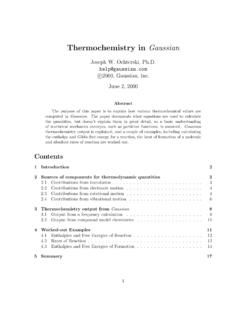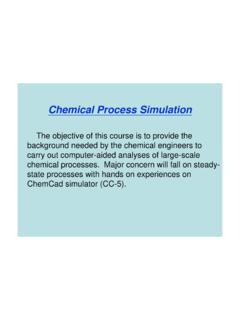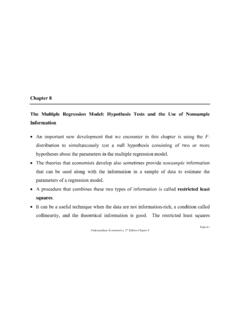Transcription of CHAPTER 1
1 C01_001-035v2 8/26/05 3:04 PM Page 1. CHAPTER . 1. The most pressing and widespread medical problems in the world today are caused by malnutrition, defined as inadequate or improper nourishment. Malnutrition comes in many forms and is present in both poor and rich nations. In less affluent, developing countries, the most significant nutritional problem among young children is the scarcity of proper foods, which leads to the development of marasmus, also called wasting disease (caused by starvation), and the disease kwashiorkor (protein inadequacy). In affluent, developed countries, the nutritional problem is the opposite extreme, with excess food consumption leading to obesity and its related diseases (see Biochemistry in the Clinic 1). Biochemists for many years have been busy studying the molecular consequences of all forms of malnutrition in their search for medical treatments and agricultural remedies for relief of the problem.
2 ( Liba Taylor/CORBIS.). Biochemistry: From Atoms to Molecules to Cells The Roots of Biochemistry Organelles, Cells, and Storage and Transfer of Early History of Biochemistry Organisms Biological Information . The Road to Modern Biochemistry Viruses A Preview All Living Matter Contains C, Living Cells Biological Information H, O, N, P, and S Prokaryotic Cells The DNA Molecule Chemical Elements in Biomolecules Eukaryotic Cells DNA S DNA. Combining Elements into Compounds DNA S RNA. mRNA S Proteins Biological Macromolecules The Genetic Code Cellular Reactions Eukaryotic DNA: Exons and Introns DNA Mutations 1. c01_001-035v2 8/26/05 3:04 PM Page 2. 2 CHAPTER 1 Biochemistry: From Atoms to Molecules to Cells Welcome to biochemistry! This subject is not entirely new because you have gained some biochemical understanding in prerequisite biology and chemistry classes.
3 But here you will encounter many more details of the complex, but always interesting and practical, concepts in biochemistry. Even though the term biochemistry, after about 100 years of use, has become commonplace in our language, a precise defini- tion is difficult and depends on who you ask. Most scientists will agree with the straightforward definition, the study of life at the molecular level. The word biochemistry has two components, biology and chemistry, and students of the dis- cipline must be well versed in the fundamentals of both subjects. What Is Biochemistry? All living organisms participate in certain processes that we define as the important characteristics of life: Organisms are able to extract energy from molecules called nutrients. Organisms display the attributes of growth, differentiation, and reproduction. Organisms have the ability to respond to changes in their environments.
4 The overall goal of biochemistry is to describe life's processes using the language of molecules, that is, applying the principles and methods of chemistry to determine molecular structure from which it is often possible to explain biological function. Even the smallest living cell contains thousands of organic and inorganic chemicals, many of them large molecules called macromolecules. All biological processes . including vision, thinking, digestion, immunity, motion, and disease conditions result from how molecules act and, sometimes, misbehave. Because most biological processes occur within the confines of the fundamental biological unit called the cell, one must know the details of cellular structure. The respective roles and importance of both chemistry and biology in achieving the goals of biochemistry are readily apparent. To better understand how biochemistry works to describe biological processes, the discipline is often organized into three primary areas (Figure ): 1.
5 Structural and functional biochemistry focuses initially on discovering the chem- ical structures and three-dimensional arrangements of biomolecules, those chemicals that are found in living matter. To describe biological processes, one must have a knowledge of the molecular structures of the participating biomole- cules, which then often leads to an understanding of the function or purpose of the cellular molecules. Figure The nature of Structure/. biochemistry showing the three function important areas of study. Information A T. T A. C G. A T. G C. T A. Bioenergetics c01_001-035v2 8/26/05 3:04 PM Page 3. Introduction 3. 2. Informational biochemistry defines the language(s) for storing biological data and for transmitting that data in cells and organisms. This area includes molecular genetics, which describes the molecular processes in heredity and expression of genetic information and also processes that communicate molecular signals to reg- ulate cellular activities ( , hormone action).
6 An organism is indeed a complex, information-processing system. 3. Bioenergetics describes the flow of energy in living organisms and how it may be transferred from one process to another. Some molecular events of cells and organisms such as muscle contraction, synthesis of molecules, and membrane transport require the input of energy (are endergonic), whereas others, like meta- bolic degradation of food and absorption of light from the sun, release energy (are exergonic). How organisms use biochemical reactions and biomolecules to transfer energy from exergonic to endergonic events will be pivotal in our under- standing of life processes. The transfer of energy usually means the transforma- tion of one type of energy to another. For example, the foods that we eat contain potential molecular energy that is used to maintain body temperature, regulate the flow of ions in nerve transmission, and to provide energy for the contraction of muscle.
7 Why Should We Study Biochemistry? Learning biochemical principles is not just important for those who will become bio- chemists and use the concepts daily. Many aspects of everyday life are related directly to the subject matter of biochemistry. Here are some of the ways that biochemistry impacts and enriches our lives: boye 1. Biochemical studies lead us to a fundamental understanding of life. All of us have g e/. r /colle w w w. w a natural curiosity about how our bodies work. What are the biochemical simi- larities and differences among the many forms of life? How do organisms store m ile y. c o and transfer information necessary to reproduce themselves? What primary mol- ecules and processes were involved in the origin of life? How is food digested to provide cellular energy? How does a brain cell store mathematical and chemical formulas? Research in biochemistry is providing answers to these and other important questions.
8 2. Biochemistry has a profound impact on our understanding of medicine, health, nutrition, and the environment. Results from biochemical studies have already led to a molecular understanding of diseases such as diabetes, sickle-cell anemia, phenylketonuria, cystic fibrosis, hypercholesterolemia, and some forms of cancer. The recent sequencing of the human genome will help in our search for cures for AIDS, Alzheimer's disease, West Nile virus, depression, influenza, and other dis- ease conditions. For example, we need to understand why people respond quite differently to drug treatments. Recombinant DNA technology and its ability to probe chromosomal regions for genetic mutations will play a major role in the diagnosis and treatment of diseases (gene therapy). Recombinant DNA will also aid in the design of new plants for agricultural purposes, which should alleviate some of the world's food and nutrition problems.
9 The study of enzymes (biologi- cal catalysts) and metabolism provides a foundation for the rational design of drugs and for the detailed understanding of nutrition. 3. Biotechnology, the application of biological materials such as cells and macro- molecules to technically useful operations, will also advance from biochemical studies. Already enzymes are used in the pharmaceutical industry to synthesize complex drugs. Various strains of microorganisms have been selected and altered A running person uses energy derived for producing therapeutic proteins, for manufacturing fuel alcohol from corn and from metabolism of carbohydrates, other plant materials, for cleaning up oil and other toxic spills, and for mining met- fats, and proteins. ( David als from natural ores. Madison/Allsport/Getty Image.). c01_001-035v2 8/26/05 3:04 PM Page 4. 4 CHAPTER 1 Biochemistry: From Atoms to Molecules to Cells Before You Go On.
10 1. Your text gave a simple, straightforward definition for biochemistry, the study of life at the molecular level. Write a more detailed definition of the field of bio- chemistry using at least 40 50 words. 2. Consider the following statement: Biochemistry is a unique discipline because it uses the principles and methods of one science to explain another science.. Name the two science disciplines referred to here, and explain the meaning of the statement. The Roots of Biochemistry Learning Objective Have an appreciation for the historical roots of biochemistry in biology, chemistry, and physics. Recognize the scope of topics within the realm of biochemistry, and the impact of the disci- pline on medicine, health, technology, and everyday life. Early History of Biochemistry People of early civilizations in Mesopotamia, egypt , China, India, Rome, and Greece did not understand the biochemical principles underlying the baking of leavened bread, the fermentation of fruit juices, or the treatment of maladies with plant and animal materials.







